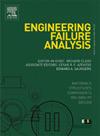新一代高速列车CFRP复合材料转向架框架在运行环境下的失效机理分析
IF 4.4
2区 工程技术
Q1 ENGINEERING, MECHANICAL
引用次数: 0
摘要
碳纤维增强聚合物(CFRP)层合复合材料由于其优异的力学性能,在新一代高速列车转向架框架中逐渐被采用。然而,碳纤维布结构在使用条件下的破坏行为仍然不够清楚。为了解决这一问题,采用了基于单元级分析的渐进疲劳损伤方法,并将其集成到基于CFRP叠合转向架框架的刚柔耦合高速列车模型中。特别是,本文建立的模型能够实时更新基于有限元法(FEM)和浮动参照系的材料刚度、强度和退化过程中的控制方程,特别适合分析CFRP叠合转向架框架在服役条件下的破坏行为。数值结果表明,在轨道不平顺性激励下,高速列车运行(以300 km/h等速直线运行100 km)时,转向架框架主要存在三种失效模式,即矩阵拉伸失效(FM3)、矩阵压缩失效(FM4)和拉伸脱层(FM5)。具体来说,当E12减少约46%-48%时发生FM3, E12减少21%-23%时触发FM4,而FM5与层间抗拉强度(S3t)减少约85%-87%相关。这些发现可能提供实用的设计指导。其中,对称±45°铺层方向应纳入剪切临界区域,如侧梁的弯曲区域,以提高剪切刚度和延迟矩阵主导的破坏。此外,局部增强,如在悬浮区域附近应用层间树脂,可以帮助减轻分层风险。该数值策略为高速铁路CFRP转向架框架的疲劳预测、优化和损伤容限设计提供了坚实的基础。本文章由计算机程序翻译,如有差异,请以英文原文为准。
Analysis of failure mechanisms for CFRP laminated composite bogie frames of the next generation high-speed trains under service environment
Carbon fiber reinforced polymer (CFRP) laminated composites are gradually adopted in next-generation high-speed train bogie frames due to their superior mechanical properties. However, the failure behavior of CFRP structures under service conditions remains insufficiently understood. To address this, a progressive fatigue damage method based on element-level analysis is employed and integrated into a novel rigid–flexible coupled high-speed train model incorporating CFRP laminated bogie frames. In particular, the model established here enables real-time updates of material stiffness, strength, and governing equations in the degradation progresses based on the finite element method (FEM) and the floating frame of reference, making it particularly well-suited for analyzing the failure behavior of CFRP laminated bogie frame under service conditions. Numerical results indicate that under the excitation of track irregularity, there are three main failure modes of the bogie frame during high-speed train operation (running 100 kilometers on a straight track with a constant speed 300 km/h), i.e., matrix tensile failure (FM3), matrix compression failure (FM4), and tensile delamination (FM5). Specifically, FM3 occurs when the is reduced by approximately 46%–48%, FM4 is triggered with a 21%–23% reduction in , and FM5 is associated with a reduction of interlaminar tensile strength () by about 85%–87%. These findings may offer practical design guidance. Among others, symmetric ±45°ply orientations should be incorporated in shear-critical regions, such as the curved areas of the side beam, to enhance shear stiffness and delay matrix-dominated failure. Additionally, localized reinforcements, such as applying interlayer resin near the suspension areas, can help mitigate delamination risk. The numerical strategy provides a robust foundation for fatigue prediction, optimization, and the development of damage-tolerant designs for CFRP bogie frames in high-speed rail applications.
求助全文
通过发布文献求助,成功后即可免费获取论文全文。
去求助
来源期刊

Engineering Failure Analysis
工程技术-材料科学:表征与测试
CiteScore
7.70
自引率
20.00%
发文量
956
审稿时长
47 days
期刊介绍:
Engineering Failure Analysis publishes research papers describing the analysis of engineering failures and related studies.
Papers relating to the structure, properties and behaviour of engineering materials are encouraged, particularly those which also involve the detailed application of materials parameters to problems in engineering structures, components and design. In addition to the area of materials engineering, the interacting fields of mechanical, manufacturing, aeronautical, civil, chemical, corrosion and design engineering are considered relevant. Activity should be directed at analysing engineering failures and carrying out research to help reduce the incidences of failures and to extend the operating horizons of engineering materials.
Emphasis is placed on the mechanical properties of materials and their behaviour when influenced by structure, process and environment. Metallic, polymeric, ceramic and natural materials are all included and the application of these materials to real engineering situations should be emphasised. The use of a case-study based approach is also encouraged.
Engineering Failure Analysis provides essential reference material and critical feedback into the design process thereby contributing to the prevention of engineering failures in the future. All submissions will be subject to peer review from leading experts in the field.
 求助内容:
求助内容: 应助结果提醒方式:
应助结果提醒方式:


